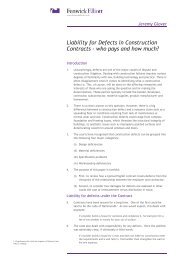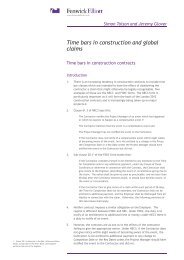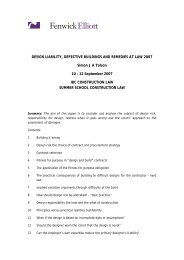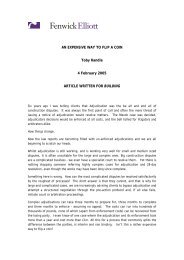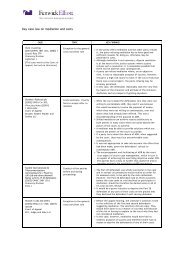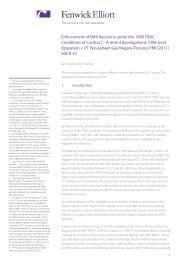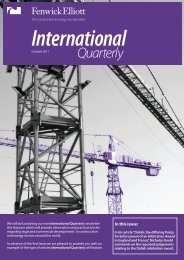Standard forms: JCT 2005, NEC3 and the Virtual ... - Fenwick Elliott
Standard forms: JCT 2005, NEC3 and the Virtual ... - Fenwick Elliott
Standard forms: JCT 2005, NEC3 and the Virtual ... - Fenwick Elliott
Create successful ePaper yourself
Turn your PDF publications into a flip-book with our unique Google optimized e-Paper software.
<strong>St<strong>and</strong>ard</strong> <strong>forms</strong>: <strong>JCT</strong> <strong>2005</strong>, <strong>NEC3</strong> <strong>and</strong> <strong>the</strong> <strong>Virtual</strong> Contract<br />
www.fenwickelliott.co.uk<br />
change. It may be that <strong>the</strong> employer accepts that it is a change <strong>and</strong> <strong>the</strong> work continues.<br />
Alternatively, <strong>the</strong> employer may withdraw <strong>the</strong> comment. No doubt, any dispute could of<br />
course be referred to adjudication.<br />
<strong>JCT</strong> major projects form<br />
The Major Protects Form (“MPF”) is a lump sum contract for larger projects. A Form of<br />
Sub-contract has also been produced. The key principle is that all design work <strong>and</strong><br />
design development beyond <strong>the</strong> initial employer design is produced by <strong>the</strong> contractor. It<br />
contains approximately 14,500 words, compared to <strong>the</strong> 85,000 words in <strong>the</strong> <strong>JCT</strong> 1998 With<br />
Contractor’s Design. The reduction in <strong>the</strong> length of <strong>the</strong> contract has been achieved by<br />
focusing on <strong>the</strong> core obligations <strong>and</strong> by not including lengthy VAT rules, clauses relating<br />
to nominated sub-contractors <strong>and</strong> suppliers <strong>and</strong> also lengthy adjudication rules. VAT<br />
rules are already covered by legislation, <strong>and</strong> in respect of <strong>the</strong> rules for adjudication <strong>the</strong><br />
legislative Scheme has simply been adopted <strong>and</strong> incorporated by reference. In addition,<br />
<strong>the</strong> MPF has made use of <strong>the</strong> Contract (Rights of Third Parties) Act 1999 in an attempt to<br />
meet employer’s needs, but at <strong>the</strong> same time avoid <strong>the</strong> production of multiple collateral<br />
warranties.<br />
The dispute resolution procedure provides for mediation, adjudication (under <strong>the</strong> Scheme)<br />
<strong>and</strong> <strong>the</strong>n litigation. This is one of <strong>the</strong> few <strong>forms</strong> that now departs from arbitration as<br />
<strong>the</strong> predominant <strong>and</strong> final form of dispute resolution, instead adopting litigation in <strong>the</strong><br />
technology <strong>and</strong> construction courts as <strong>the</strong> final method of dispute resolution. It is true<br />
that <strong>the</strong> <strong>JCT</strong> 1998 versions of <strong>the</strong> Contract provide for court proceedings as an alternative,<br />
however, <strong>the</strong> default mechanism is still arbitration.<br />
The payment provisions provide options including Interim Valuations (Rule A), Stage<br />
Payments (Rule B), Schedule of Payments (Rule C) or o<strong>the</strong>r terms which <strong>the</strong> parties<br />
might decide to incorporate. Interim Payments remain <strong>the</strong> predominant method, <strong>and</strong> a<br />
single payment notice is to be issued, covering any amounts to be withheld. The Form<br />
is <strong>the</strong>refore combining <strong>the</strong> requirements of Section 110 <strong>and</strong> Section 111 of <strong>the</strong> Housing<br />
Grants, Construction <strong>and</strong> Regeneration Act 1996 by <strong>the</strong> provision of a single notice, thus<br />
attempting to avoid arguments as to whe<strong>the</strong>r a Section 111 Withholding Notice has been<br />
properly served at <strong>the</strong> correct time <strong>and</strong> or in <strong>the</strong> correct format.<br />
At <strong>the</strong> o<strong>the</strong>r end of <strong>the</strong> scale are minor works agreements.<br />
Short form agreements<br />
A variety of short st<strong>and</strong>ard form contracts have been produced:<br />
• <strong>JCT</strong> <strong>2005</strong> Minor Works Building Contract (MW) <strong>and</strong> a separate version<br />
With Contractor’s Design (MWD) replacing <strong>the</strong> <strong>JCT</strong> 1998 Agreement for<br />
Minor Works;<br />
• ICE Conditions of Contract for Minor Works 3 rd Edition: July 2004; <strong>and</strong><br />
• NEC The Engineering <strong>and</strong> Construction Short Contract 1999.<br />
The <strong>JCT</strong> Minor Works Agreement has been around for some time, <strong>and</strong> was initially<br />
proposed for projects under £50,000 in value. The form is also valuable for use on larger<br />
value projects with a simple content. While <strong>the</strong> guidance as to <strong>the</strong> maximum figure has<br />
increased, <strong>the</strong> form is often used for higher value <strong>and</strong> complex projects. This is often<br />
because of <strong>the</strong> familiarity of a particular consultant with <strong>the</strong> Minor Works Agreement.<br />
11




